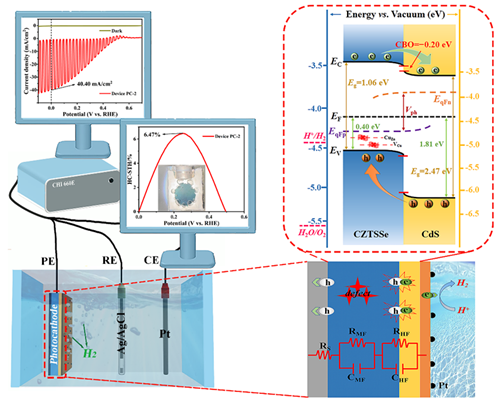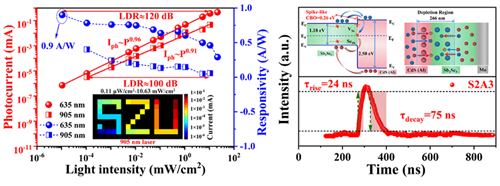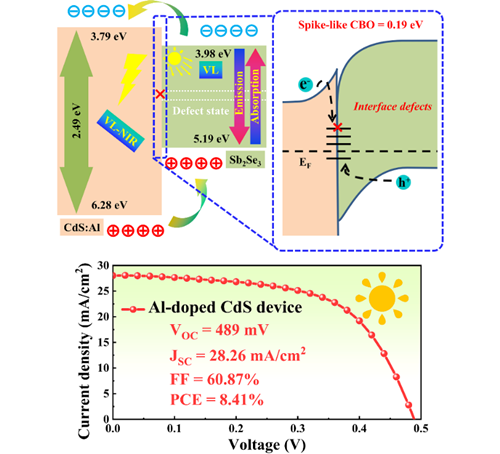Recently, Professor Fan Ping's team from the College of Physics and Optoelectronic Engineering at Shenzhen University, including Researcher Liang Guangxing, published their latest research findings in top international journals in the field of materials science and physics, including Advanced Energy Materials (impact factor: 29.698), InfoMat (impact factor: 24.798), and Advanced Functional Materials (impact factor: 19.924). Their research focused on the use of all-inorganic sulfur-based thin films for applications in solar cells, photocatalytic hydrogen production, and photodetectors.
CZTSSe Thin Film Solar Cells:
The study investigated the utilization of CZTSSe (Copper Zinc Tin Sulfide Selenide) as a promising thin-film photovoltaic material due to its composition of inexpensive and non-toxic elements, along with a theoretical photovoltaic conversion efficiency exceeding 32%. Despite the continuous improvement in efficiency of CZTSSe thin-film solar cells in recent years, they still fall short of their theoretical values, primarily due to significant open-circuit voltage losses. The researchers employed a non-vacuum, environmentally friendly sol-gel method combined with selenization heat treatment to grow CZTSSe thin films. They analyzed the selenization reaction mechanism in depth, elucidating for the first time the vapor components (gaseous SnSe3) that suppress tin loss and the SnSe3 that promotes CZTSSe formation pathways. By optimizing the selenization conditions using SnS, SnSe2 powders, and Se granules, they obtained highly crystalline and compositionally controllable CZTSSe thin films for the absorber layer. Physical analysis of the resulting CZTSSe thin-film solar cells demonstrated that the high crystalline quality of the absorber layer optimizes the band bending at the grain boundaries and effectively suppresses interface recombination. Additionally, the concentrations of CuZn and CuSn antisite defects were significantly reduced, leading to an increase in the open-circuit voltage from 508 mV to 546 mV. The study achieved the highest photovoltaic conversion efficiency of CZTSSe thin-film solar cells prepared in ambient air conditions, reaching 12.89%. The research was published in Advanced Energy Materials (2023) 2300521, with Liang Guangxing and Su Zhenghua as corresponding authors, master's student Yu Zixuan as the first author, and Shenzhen University as the sole corresponding unit.

Link:https://doi.org/10.1002/aenm.202300521
CZTSSe Thin Film Photocathodes for Solar Hydrogen Production:
Building upon the excellent optoelectronic properties of CZTSSe thin films, the researchers developed Glass/Mo/CZTSSe/CdS/TiO2/Pt thin-film photocathodes to achieve solar-driven "green hydrogen" production through water splitting. By optimizing the performance of the heterojunction interface between the CZTSSe thin film and the co-absorber layer, they significantly suppressed interface non-radiative recombination losses, thereby improving the charge separation and transfer efficiency. They increased the photocurrent density of the CZTSSe thin-film photocathode to the highest reported value of 40.40 mA cm−2, approaching its theoretical photocurrent density value of 42.85 mAcm−2. Additionally, they achieved a solar-to-hydrogen conversion efficiency of 6.47% in half-cell configurations. The research was published in Advanced Energy Materials (2023) 2300215, with Liang Guangxing as the first author, master's student Li Zhidong as the second author, Chen Shuo as the corresponding author, and Shenzhen University as the sole corresponding unit.

Link:https://doi.org/10.1002/aenm.202300215
Sb2Se3 Thin Film Photodetectors:
The study explored the potential of Sb2Se3 in the field of high-efficiency, low-cost thin-film photodetectors. Sb2Se3 garnered attention due to its advantages, including its one-dimensional crystal structure, absence of lateral crosstalk between detector pixels, complementary defect compensation, and compatibility with CMOS processes. The researchers fabricated highly oriented Sb2Se3 thin films via sputtering selenization and constructed excellent Sb2Se3/CdS planar heterojunction photodetectors. To further enhance device performance, they introduced Al3+ ion doping into the CdS buffer layer, reducing interface and bulk defect densities, increasing the depletion layer width, optimizing the p-n junction interface band alignment, and further reducing carrier recombination in the devices. Consequently, the thin-film photodetectors achieved self-powered operation without an external bias, with a responsivity of 0.9 A/W, a detectivity of 4.78×1012 Jones, a switch ratio of up to 106, a linear dynamic range of up to 120 dB, and a response speed reaching the nanosecond level for the first time (response time of 24 ns and recovery time of 75 ns). The research was published in InfoMat (2023) e12400, with Chen Shuo as the first author, master's student Fu Yi as the second author, Liang Guangxing as the corresponding author, and Shenzhen University as the sole corresponding unit.

Link: http://doi.org/10.1002/inf2.12400
A heterogeneous junction interface optimization strategy is proposed, in which Al3+ ions are introduced into the CdS buffer layer and subjected to heat treatment. This strategy effectively transforms the band alignment of the Sb2Se3/CdS:Al heterojunction from a "cliff-like" structure to an ideal "long-nail-like" structure, thereby reducing the defect density at the heterojunction interface, suppressing non-radiative recombination of charge carriers, and improving the performance of solar cells. Finally, the study summarizes and analyzes the significance of optimizing the carrier dynamics of Sb2Se3 thin-film solar cells for further enhancing solar cell efficiency. The related research results were published in Advanced Functional Materials (2023) 2213941 (impact factor: 19.924), with Guangxing Liang and Shuo Chen as the corresponding authors. Yanxi Luo, a jointly supervised doctoral student under their guidance, is listed as the first author. Shenzhen University is the sole corresponding unit.

Link:https://doi.org/10.1002/adfm.202213941
Thanks to the support from the National Natural Science Foundation of China (General Program), the National Natural Science Foundation of China (Youth Program), the Major Scientific Research Project of the Guangdong Provincial Department of Education, the General Program of the Natural Science Foundation of Guangdong Province, the Key Project of Shenzhen City, and the Liyuan Outstanding Youth Project of Shenzhen University (Phase 1 and Phase 2).


![]() Add : No. 3688, Nanhai Avenue, Nanshan District, Shenzhen, Guangdong Province
Add : No. 3688, Nanhai Avenue, Nanshan District, Shenzhen, Guangdong Province ![]() Email : cpoe@szu.edu.cn
Email : cpoe@szu.edu.cn ![]() Phone: 0755-26538735
Phone: 0755-26538735 ![]() Fax : 0755-26538735
Fax : 0755-26538735